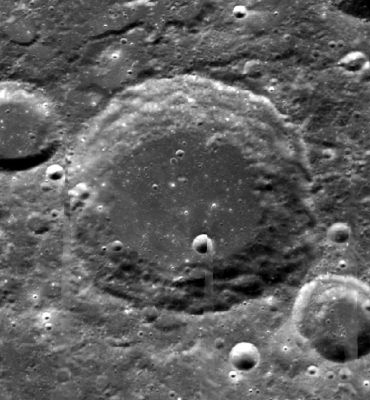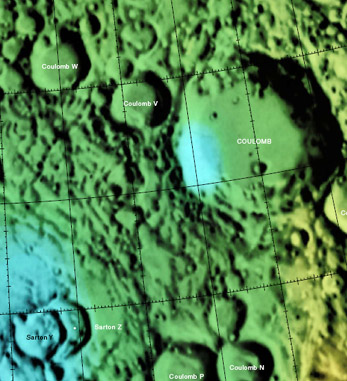Difference between revisions of "Coulomb"
| (One intermediate revision by the same user not shown) | |||
| Line 6: | Line 6: | ||
|- | |- | ||
| | | | ||
| − | [http://lpod.org/coppermine/displayimage.php?pid=4304fullsize=1 [[Image: | + | [http://lpod.org/coppermine/displayimage.php?pid=4304fullsize=1 [[Image:Normal_coulomb-large.jpg|external image normal_coulomb-large.jpg]]]<br /> |
| | | | ||
| − | [[Image: | + | [[Image:Coulomb-color.jpg|coulomb-color.jpg]]<br /> |
|} | |} | ||
'''Left:''' [http://www.mapaplanet.org/explorer-bin/explorer.cgi?map=Moon&layers=moon_clementine_base_v2&west=252&south=206&east=395&north=99¢er=247.75¢er_lat=0&defaultcenter=on&grid=none&stretch=auto&resamp_method=nearest_neighbor&projection=SIMP&r=1&g=1&b=1&advoption=YES&info=NO&resolution=16&lines=360&samples=720&scale=1.89520&imageTopX=-681327.7906775475&imageTopY=1917004.3401122093&box=yes&x=389&y=200 Clementine] image from [http://www.mapaplanet.org Map-A-Planet]. '''Right:''' [http://planetarynames.wr.usgs.gov/images/Lunar/lac_20.pdf Color-coded topography LAC 20] image from [[USGS%20Digital%20Atlas|USGS Digital Atlas]].<br /> <div id="toc"> | '''Left:''' [http://www.mapaplanet.org/explorer-bin/explorer.cgi?map=Moon&layers=moon_clementine_base_v2&west=252&south=206&east=395&north=99¢er=247.75¢er_lat=0&defaultcenter=on&grid=none&stretch=auto&resamp_method=nearest_neighbor&projection=SIMP&r=1&g=1&b=1&advoption=YES&info=NO&resolution=16&lines=360&samples=720&scale=1.89520&imageTopX=-681327.7906775475&imageTopY=1917004.3401122093&box=yes&x=389&y=200 Clementine] image from [http://www.mapaplanet.org Map-A-Planet]. '''Right:''' [http://planetarynames.wr.usgs.gov/images/Lunar/lac_20.pdf Color-coded topography LAC 20] image from [[USGS%20Digital%20Atlas|USGS Digital Atlas]].<br /> <div id="toc"> | ||
| Line 17: | Line 17: | ||
''([[LAC%20zone|LAC zone]] 20C2)'' [http://planetarynames.wr.usgs.gov/images/Lunar/lac_20.pdf USGS Digital Atlas PDF]<br /> <br /> | ''([[LAC%20zone|LAC zone]] 20C2)'' [http://planetarynames.wr.usgs.gov/images/Lunar/lac_20.pdf USGS Digital Atlas PDF]<br /> <br /> | ||
==Description== | ==Description== | ||
| − | '''Coulomb''' is a crater of the [[Stratigraphy|Nectarian]] period (3.92 to 3.85 bn years), and lies within the north-eastern sector of the [[Coulomb-Sarton%20Basin|Coulomb-Sarton Basin]] -- a basin some 530 km-wide and [[Stratigraphy|pre-Nectarian]] in age (4.6 to 3.92 bn years). The crater looks relatively fresh for its age; consisting of a well-preserved rim whose inner sectors show series of worn terraces. Minor craters have impacted mostly the southern and south-eastern sectors of the crater, while ejecta deposits nearby from the younger [[Imbrium%2C%20Mare|Imbrium Basin]] some 2000 km away to the south-east have left their mark mainly on the outer sectors. The floor looks very fresh and flat, but more than likely we're looking at the result of some internal lava-flooding through, possibly, initial rilles or surface cracks now covered over, or, perhaps, the result from initial impact that produced '''Coulomb'''; smashng into a thinner, suface region which led to tapping of lava underneath. Curiously, both '''Coulomb V''' to the north-we<br /> st of the crater and '''Coulomb J''' to the south-east show similar signs of inner flooding; so the latter suggestion might not be all far from the truth (but, open to correction). <span class="membersnap">- | + | '''Coulomb''' is a crater of the [[Stratigraphy|Nectarian]] period (3.92 to 3.85 bn years), and lies within the north-eastern sector of the [[Coulomb-Sarton%20Basin|Coulomb-Sarton Basin]] -- a basin some 530 km-wide and [[Stratigraphy|pre-Nectarian]] in age (4.6 to 3.92 bn years). The crater looks relatively fresh for its age; consisting of a well-preserved rim whose inner sectors show series of worn terraces. Minor craters have impacted mostly the southern and south-eastern sectors of the crater, while ejecta deposits nearby from the younger [[Imbrium%2C%20Mare|Imbrium Basin]] some 2000 km away to the south-east have left their mark mainly on the outer sectors. The floor looks very fresh and flat, but more than likely we're looking at the result of some internal lava-flooding through, possibly, initial rilles or surface cracks now covered over, or, perhaps, the result from initial impact that produced '''Coulomb'''; smashng into a thinner, suface region which led to tapping of lava underneath. Curiously, both '''Coulomb V''' to the north-we<br /> st of the crater and '''Coulomb J''' to the south-east show similar signs of inner flooding; so the latter suggestion might not be all far from the truth (but, open to correction). <span class="membersnap">- JohnMoore2</span><br /> <br /> |
===Wikipedia=== | ===Wikipedia=== | ||
[http://en.wikipedia.org/wiki/Coulomb_(crater) Coulomb]<br /> <br /> | [http://en.wikipedia.org/wiki/Coulomb_(crater) Coulomb]<br /> <br /> | ||
| Line 28: | Line 28: | ||
* '''Coulomb''' is in the long list of farside feature names approved by the IAU in 1970 and published in [http://the-moon.us/wiki/Menzel%2C%201971#COULOMB Menzel, 1971]. | * '''Coulomb''' is in the long list of farside feature names approved by the IAU in 1970 and published in [http://the-moon.us/wiki/Menzel%2C%201971#COULOMB Menzel, 1971]. | ||
* In Antonín Rükl's 1972 ''[[R%C3%BCkl|Maps of lunar hemispheres]]'' the name '''Coulomb''' is attached to the 60-km crater presently known as '''[[Kramers|Kramers]] C''' and the present crater is labeled '''Nechvile''' (research: Danny Caes). | * In Antonín Rükl's 1972 ''[[R%C3%BCkl|Maps of lunar hemispheres]]'' the name '''Coulomb''' is attached to the 60-km crater presently known as '''[[Kramers|Kramers]] C''' and the present crater is labeled '''Nechvile''' (research: Danny Caes). | ||
| − | ** According to p. 11 of Rükl's accompanying pamphlet, this assignment was made at the suggestion of [[Photographic%20Atlas%20of%20the%20Moon|Prof. Z. Kopal]], whose recommendation to name a crater after Czechoslovakian astronomer '''Vincent Nechville''' (1890 - 1964) was ultimately rejected by the IAU. Since Rükl was aware of [[Menzel%2C%201971|Menzel, 1971]], it is unclear why he (and Kopal?) re-named the crater already assigned by the IAU to '''Coulomb''' and moved '''Coulomb''''s name to a smaller crater nearby. One might think they would have simply suggested assigning '''Nechville''''s name to the then-anonymous '''[[Kramers|Kramers]] C'''. In 1927, '''Nechvile''' [http://adsabs.harvard.edu/full/seri/PASP./0040/0000065.000.html won] the [[Lalande|Lalande]] Prize of the French Academy of Sciences for his work on star streams. His name has not been subsequently used on the Moon. <span class="membersnap">- | + | ** According to p. 11 of Rükl's accompanying pamphlet, this assignment was made at the suggestion of [[Photographic%20Atlas%20of%20the%20Moon|Prof. Z. Kopal]], whose recommendation to name a crater after Czechoslovakian astronomer '''Vincent Nechville''' (1890 - 1964) was ultimately rejected by the IAU. Since Rükl was aware of [[Menzel%2C%201971|Menzel, 1971]], it is unclear why he (and Kopal?) re-named the crater already assigned by the IAU to '''Coulomb''' and moved '''Coulomb''''s name to a smaller crater nearby. One might think they would have simply suggested assigning '''Nechville''''s name to the then-anonymous '''[[Kramers|Kramers]] C'''. In 1927, '''Nechvile''' [http://adsabs.harvard.edu/full/seri/PASP./0040/0000065.000.html won] the [[Lalande|Lalande]] Prize of the French Academy of Sciences for his work on star streams. His name has not been subsequently used on the Moon. <span class="membersnap">- JimMosher</span> |
<br /> | <br /> | ||
==LPOD Articles== | ==LPOD Articles== | ||
Latest revision as of 20:08, 16 April 2018
Contents
Coulomb (Zdenek Kopal's Nechville)
|
Lat: 54.44°N, Long: 115.08°W, Diam: 89.72 km, Depth: km, Rükl: (farside) Nectarian | |
Images
LPOD Photo Gallery Lunar Orbiter Images
Maps
(LAC zone 20C2) USGS Digital Atlas PDF
Description
Coulomb is a crater of the Nectarian period (3.92 to 3.85 bn years), and lies within the north-eastern sector of the Coulomb-Sarton Basin -- a basin some 530 km-wide and pre-Nectarian in age (4.6 to 3.92 bn years). The crater looks relatively fresh for its age; consisting of a well-preserved rim whose inner sectors show series of worn terraces. Minor craters have impacted mostly the southern and south-eastern sectors of the crater, while ejecta deposits nearby from the younger Imbrium Basin some 2000 km away to the south-east have left their mark mainly on the outer sectors. The floor looks very fresh and flat, but more than likely we're looking at the result of some internal lava-flooding through, possibly, initial rilles or surface cracks now covered over, or, perhaps, the result from initial impact that produced Coulomb; smashng into a thinner, suface region which led to tapping of lava underneath. Curiously, both Coulomb V to the north-we
st of the crater and Coulomb J to the south-east show similar signs of inner flooding; so the latter suggestion might not be all far from the truth (but, open to correction). - JohnMoore2
Wikipedia
Additional Information
- IAU page: Coulomb
Nomenclature
- Named for Charles Augustin de Coulomb (June 14, 1736 - August 23, 1806), a French physicist. He is best known as the discoverer of Coulomb's law which defines the force of electrostatic attraction and repulsion. The SI unit of charge, the coulomb, was so named in his honor. Coulomb is distinguished in the history of mechanics and of electricity and magnetism. In 1779 he published an important investigation of the laws of friction, which was followed by a memoir on viscosity.
- Coulomb is in the long list of farside feature names approved by the IAU in 1970 and published in Menzel, 1971.
- In Antonín Rükl's 1972 Maps of lunar hemispheres the name Coulomb is attached to the 60-km crater presently known as Kramers C and the present crater is labeled Nechvile (research: Danny Caes).
- According to p. 11 of Rükl's accompanying pamphlet, this assignment was made at the suggestion of Prof. Z. Kopal, whose recommendation to name a crater after Czechoslovakian astronomer Vincent Nechville (1890 - 1964) was ultimately rejected by the IAU. Since Rükl was aware of Menzel, 1971, it is unclear why he (and Kopal?) re-named the crater already assigned by the IAU to Coulomb and moved Coulomb's name to a smaller crater nearby. One might think they would have simply suggested assigning Nechville's name to the then-anonymous Kramers C. In 1927, Nechvile won the Lalande Prize of the French Academy of Sciences for his work on star streams. His name has not been subsequently used on the Moon. - JimMosher
LPOD Articles
Bibliography
Named Features -- Prev: Couder -- Next: Courtney

